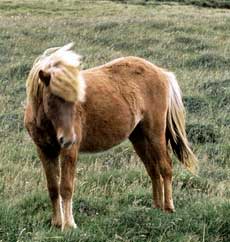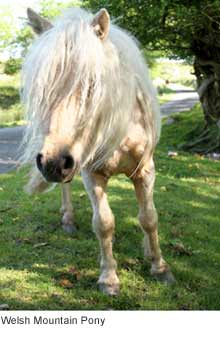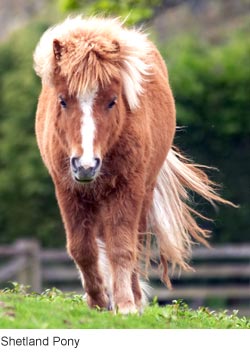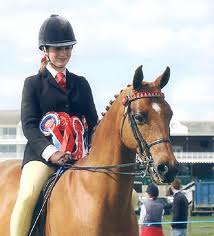What is a PONY ?
What is a PONY ?
Wed May 21po·ny
|
Noun
|
A pony is a breed of horse which has a number of distinct traits, most notably a small size. Numerous pony breeds can be found all over the world, and some well known representatives of this equine group include Shetland, Welsh, and Connemara ponies. Just like their larger relatives, ponies have been used for work, sport, and pleasure for thousands of years, and they are incredibly diverse creatures.
A pony is not merely a small horse. There are several distinct physical differences between horses and ponies which make the two easy to distinguish. Ponies tend to very stocky, with thick bones, wide chests, and small heads. Their manes, tails, and coats are often thicker than those of horses, perhaps because many pony breeds evolved in colder climates where a thick layer of insulation would be vital.
Ponies are also incredibly strong for their size, thanks to their muscular bodies. A mature pony can sometimes pull the same weight as a draft horse, for example, and many ponies are capable of carrying adult riders. Pound for pound, ponies are much stronger than horses. They are also known for being extremely hardy, and tolerant of a wide range of conditions including extreme cold. The pony is also famous for being extremely intelligent, and sometimes a bit stubborn.
Showing purposes
14.2 hh and up is a horse
 Sizes and Scales:Ponies are 14.2 hands (abbreviated hh) (1.47 m) at the withers or smaller, while a horse is anything taller than 14.2 hh at the withers.
Sizes and Scales:Ponies are 14.2 hands (abbreviated hh) (1.47 m) at the withers or smaller, while a horse is anything taller than 14.2 hh at the withers.
What's in a Name? The term "pony" can be used generally for any small horse, regardless of its actual measurements. It is interesting to note, however, that some equine breeds are not considered ponies, even if they are under 14.2 hh, because of their fiery temperament.
All For Show: For showing purposes, ponies are grouped into small, medium, and large sizes. Small ponies are 12.2 hh and under, medium ponies are over 12.2 but no taller than 13.2 hh (1.27 to 1.37 m), and large ponies are over 13.2 hh but no taller than 14.2 hh (1.37 to 1.47 m).
Note, however, that miniature horses are not the same as ponies. A miniature horse is in fact much smaller, required to be no taller than 8.2 hh (86cm) at the withers. There are also miniature pony breeds.
Wild Ponies?There are several wild breeds of pony, and these have often been captured and bred for various purposes, especially in Britain and Ireland.
 These wild breeds along with domestic breeds were used as "pit ponies" hauling loads of coal up from the mines, for freight transport, as children's mounts and for entertainment, and later as competitors and performers in their own right. They were also ridden (and continue to be ridden) by adults, as ponies are usually very strong.
These wild breeds along with domestic breeds were used as "pit ponies" hauling loads of coal up from the mines, for freight transport, as children's mounts and for entertainment, and later as competitors and performers in their own right. They were also ridden (and continue to be ridden) by adults, as ponies are usually very strong.
Ponies are often said to be mean, untrustworthy, spooky or devious. Properly trained ponies can be gentle, and are appropriate mounts for children who are learning to ride.
The Riding Pony was developed in the United Kingdom, and was such a success that it is now bred all over the world. They are excellent show ponies. The breed is an extremely elegant animal, more like a small horse than a pony. It has a small head and small, neat ears.
They are compact, with sloping shoulders and a narrow front. Their feet are tough and they possess strong limbs. They are well-proportioned with comfortable gaits and free-flowing movement.
What's Your Type? There are three types of ponies:
* The show pony: super-elegant miniature show hack with pony features
* The show hunter: similar to the show pony, but with more substance
* The working hunter: stockier, and more workmanlike
Shetland ponies, also known as shelts, are small (on average up to 42 inches to the wither) but strong for their size. The Shetland Pony originated from the Shetland Islands - North East of Scotland.
 The ancient ponies' roots are unknown, though it is believed that they are related to the ancient Scandinavian ponies from when the islands were joined with Scandinavia
The ancient ponies' roots are unknown, though it is believed that they are related to the ancient Scandinavian ponies from when the islands were joined with Scandinavia
(up until 8000 BC).
They were probably influenced by the Celtic Pony, taken by the Celts between 2000 and 1000 BC. The harsh climate and scarce food developed the ponies into extremely hardy animals. They were first used for carrying peat and ploughing. Then, in the mid-19th century, when laws were passed prohibiting children from working in coal mines, thousands of Shetlands traveled to Mainland Britain to be 'pit ponies,' working underground their whole lives
hauling coal.
Versatility in a Pony: The United States mid-west coal mines also imported some of these animals. The Shetland Pony Stud Book Society was started in 1890 to maintain purity and encourage high-quality animals. In 1956, the Shetland Islands Premium Stallion Scheme was formed to subsidize high-quality registered stallions to improve the breeding stock. Today, Shetlands are used as children's ponies and are also featured in the Shetland Pony Grand National, galloping around the course with their young jockeys.
What sizes do pony halters & bridles come in?
We have labeled all of our halters and bridles to fit the typical pony of the size mentioned. These are guidelines only! Sometimes an animal will have a smaller or bigger head for his size, plus different breeds have different shaped heads. For example, Welsh ponies usually have small muzzles and broad foreheads. Stallions will have much larger jowels as will Arabians or part Arabs.
| Size | Height | Notes |
| Small Pony | 12.2 hands and under | Sometimes called 'Shetland' |
| Medium Pony | Over 12.2 and up to 13.2 hands | |
| Large Pony | Over 13.2 and up to 14.2 hands | Often equivalent to 'Horse Yearling' |
| Cob | Over 14 and up to 15.2 hands | For larger Larges and Small Horses |
| Small/Med | 12 - 13 hands | For larger Smalls and smaller Mediums |
| Med/Large | 13 -14 hands | For larger Mediums and smaller Larges |
| Large Pony/Cob | 14 - 15 hands | For larger Larges and Small Horses |
How do I measure for a pony halter?
To measure for a halter, use a flexible measuring tape and take the following measurements. You can then email them to us and we can check the measurements against any of our products. We have labeled all of our halters to fit the typical pony of the size mentioned (see first FAQ)
- The distance from an inch or two below the point of the cheekbone on one side, over the crown, to the same point on the other side. The starting and end points are where the halter side rings will be.
- The distance around the nose (circumference) at the points mentioned above.
How do I measure for a pony bridle?
To measure for a bridle, use a flexible measuring tape and take the following measurements. You can then email them to us and we can check the measurements against any of our products. We have labeled all of our bridles to fit the typical pony of the size mentioned (see first FAQ)
- The distance from the corner of the mouth on one side, over the crown, to the same point on the other side
- The distance around the nose (circumference) where you want your bridle's noseband to lie
- The distance around the throat and over the crown where the throat latch goes. Make this measurement as loose as the throat latch will be
- The browband measurement from behind the ear, across the forehead, to the same place on the other side (where the browband will be)
- The type of bit you will be using (Dee, Eggbutt, Full Cheek, etc.) The size of the rings in various bits will affect the fit of your bridle
How do I measure for a pony in-hand bridle?
Please send us the following measurements, following the diagram, to ensure a good fit. Also, if you're ordering a bridle that uses a bit, please indicate the type of bit you'll be using including the size of the ring.
- From the corner of the mouth on one side, over the poll, to the corner of the mouth on the other side
- Noseband - measure completely around nose where noseband will be - about two fingers below cheekbone
- Throat - from the poll, completely around, going under the throat. (fairly snug)
- Browband - from behind the ear, across the forehead, to the same place on the other side
- Distance between splits -From where the browband meets the bridle (about 1" below the ear), over the poll, to the same place on the other side
| Category : | Animal Articles |
| Listing ID : | 5758 |








